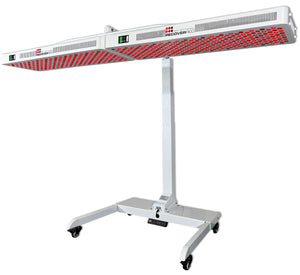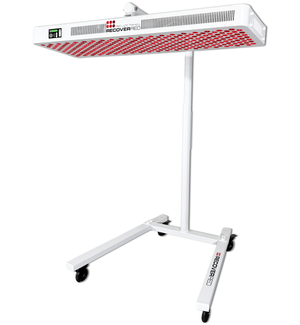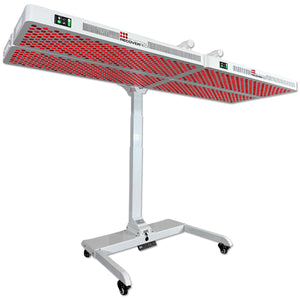Stress and anxiety impact millions of people's daily lives and well-being. [1] While various methods exist to cope with anxiety and stress, some individuals may seek natural and effective alternatives.
If you're the one seeking a natural solution to reduce stress, red light therapy might be worth considering. In this article, we’ll explore the connection between RLT and anxiety, how it relieves stress, and the scientific research supporting its effectiveness.
Understanding Red Light Therapy
Red light therapy utilizes low-intensity red light to stimulate healing throughout the body. By penetrating deep into cells, red light therapy enhances cellular energy production, increasing blood circulation and reducing inflammation. Moreover, it can modulate hormones and neurotransmitters associated with mood and behavioral changes.
The Connection Between Light and Anxiety
Humans require sunlight for optimal health, and insufficient exposure to natural light can lead to stress, anxiety, and depression and adversely affect physical and mental well-being. Lack of sunlight depletes serotonin and dopamine levels in the brain, essential for maintaining a balanced mood.
Scientific research supports the effectiveness of RLT for stress relief. A study published in the Journal of Psychiatric Research showed that red light exposure significantly reduced anxiety scores in individuals with generalized anxiety disorder. [2]
How Does Red Light Therapy Help With Stress Relief?
RLT has been scientifically proven to provide stress relief through various mechanisms:
1. Increasing Energy Levels
Red light therapy restores energy levels by enhancing cellular energy and ATP production, helping you feel more revitalized and motivated. [3]
2. Balanced Mood
RLT promotes a positive mood and reduces anxiety by supporting the production of serotonin and dopamine.
3. Regulated Circadian Rhythms
Stress often disrupts sleep patterns, resulting in insomnia or excessive sleepiness. Red light therapy helps regulate circadian rhythms, promoting better sleep.
4. Reduced Oxidative Stress
Anxiety increases oxidative stress, an imbalance between free radicals and antioxidants. RLT stimulates the production of natural antioxidants in the body, reducing cellular damage and slowing down the aging process.
5. Reduced Inflammation
Anxiety triggers inflammation in the body, worsening symptoms and increasing the risk of chronic diseases. RLT helps reduce inflammation by suppressing pro-inflammatory cytokines and modulating your immune system. [4]
6. Mental Clarity and Confidence
Red light therapy improves cognitive function, enhancing mental clarity and boosting confidence.
7. General Positivity and Calm
Regular red light therapy sessions can contribute to an overall sense of calm and positivity, reducing stress and anxiety.
Incorporating Red Light Therapy into Your Routine
To experience the stress-relieving benefits of red light therapy, you can incorporate it into your daily routine. Consider using red light therapy devices emitting red or near-infrared light within the appropriate wavelength range. Exposing yourself to the light source for 10 to 20 minutes during the morning or afternoon is recommended. The frequency of sessions can be tailored to your needs and preferences.
Try Red Light Therapy Today and Reclaim Your Peace of Mind!
RLT offers a natural and non-invasive approach to anxiety relief. This therapy enhances energy levels, balances mood, improves cognitive function, and promotes overall well-being by harnessing the power of red and near-infrared light. While red light therapy can be beneficial, it should be used with professional guidance and not as a substitute for conventional treatments.
So, incorporate red light therapy into your routine today and experience the revitalizing effects on your mind and body!
Reference
- Author , A. (2023). Anxiety disorders and depression research & treatment. Anxiety and Depression Association of America, ADAA. https://adaa.org/
- Schiffer, F., Johnston, A. L., Ravichandran, C., Polcari, A., Teicher, M. H., Webb, R. H., & Hamblin, M. R. (2009, December 8). Psychological benefits 2 and 4 weeks after a single treatment with near infrared light to the forehead: A pilot study of 10 patients with major depression and anxiety. Behavioral and brain functions : BBF. https://www.ncbi.nlm.nih.gov/pmc/articles/PMC2796659/
- GE, G. (2021). Photobiomodulation: The clinical applications of low-level light therapy. Aesthetic surgery journal. https://pubmed.ncbi.nlm.nih.gov/33471046/
- P, C. (2016). Review of Transcranial Photobiomodulation for major depressive disorder: Targeting brain metabolism, inflammation, oxidative stress, and neurogenesis. Neurophotonics. https://pubmed.ncbi.nlm.nih.gov/26989758/




